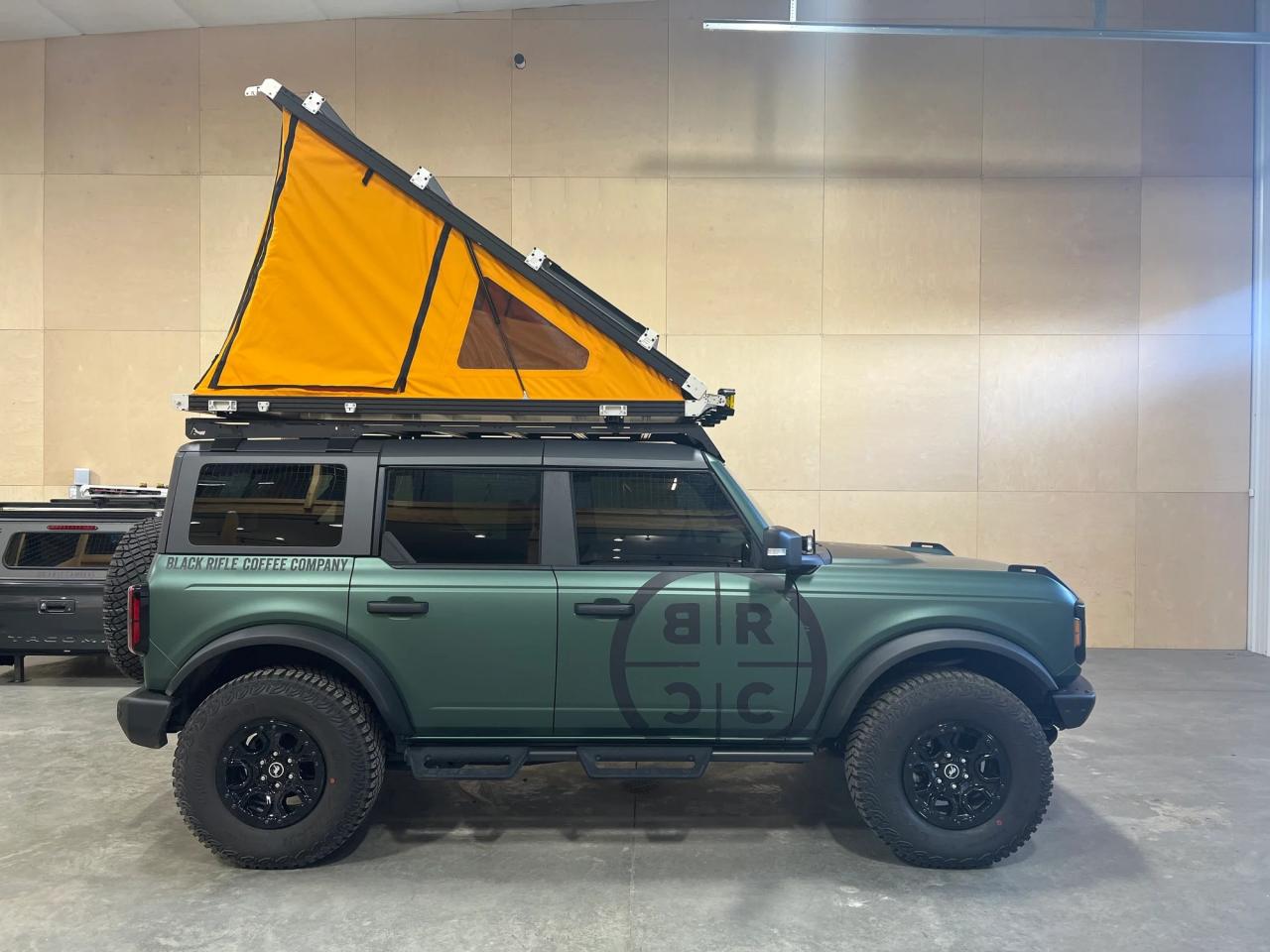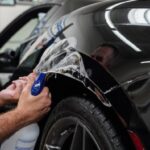Best rooftop tents for Ford Bronco 2025? Dude, hitting the trails in your new Bronco is awesome, but sleeping under the stars? Even better. This guide breaks down everything you need to know about finding the perfect rooftop tent for your 2025 Bronco, from compatibility and features to installation and maintenance. Get ready to upgrade your overlanding game!
We’ll cover crucial factors like roof rack compatibility, weight limits, and essential features for off-road adventures. We’ll compare hard-shell vs. soft-shell options, discuss waterproofing and ventilation, and even give you a step-by-step installation guide. Plus, we’ll help you budget for your perfect setup, ensuring you get the best bang for your buck.
Rooftop Tent Compatibility with 2025 Ford Bronco
Choosing the right rooftop tent for your 2025 Ford Bronco requires careful consideration of several factors to ensure a safe and secure setup. The Bronco’s dimensions, roof strength, and weight capacity all play a crucial role in determining compatibility. Incorrectly matching a tent to your vehicle could lead to damage, instability, or even accidents.
Roof Rack Requirements and Weight Limits
The 2025 Ford Bronco’s roof strength and weight capacity are primary considerations when selecting a rooftop tent. Exceeding the vehicle’s weight limit can significantly impact handling and safety. The type of roof rack installed is equally important, as it distributes the weight of the tent and its occupants. A robust rack is essential to prevent damage to the vehicle’s roof and ensure stability during travel.
So you’re looking at rooftop tents for your sweet new 2025 Ford Bronco? Awesome! But if you’re planning on hauling a serious setup, you might want to check out this guide on How to increase towing capacity on a RAM 1500 – it’s got some helpful tips, even if you’re not rocking a Ram. Knowing your towing limits is key before you start loading up that Bronco with gear and a rooftop tent!
Always consult your Bronco’s owner’s manual for specific weight limitations and recommendations regarding roof rack installations. Consider the combined weight of the tent, occupants, and gear when making your selection. For example, a tent weighing 150 lbs plus two adults (300 lbs) and camping gear (50 lbs) totals 500 lbs. Ensure your chosen roof rack and vehicle can safely support this load.
Common Roof Rack Systems for the 2025 Ford Bronco
Several roof rack systems are compatible with the 2025 Ford Bronco, each offering unique advantages and disadvantages.
Here are three examples:
- OEM Ford Bronco Roof Rack: This factory-installed option offers seamless integration and often comes with a warranty. Advantages include ease of installation and a guaranteed fit. Disadvantages might include higher cost compared to aftermarket options and potentially limited customization.
- Thule Roof Rack System: A popular aftermarket choice, Thule offers a range of racks designed for various vehicles, including the Bronco. Advantages include robust construction, extensive customization options, and a wide network of retailers. Disadvantages might be a slightly more complex installation process compared to OEM options and a potentially higher price point than some other aftermarket brands.
- Yakima Roof Rack System: Similar to Thule, Yakima provides high-quality aftermarket roof racks. Advantages include durable materials, a good selection of accessories, and generally good customer support. Disadvantages might include a slightly steeper learning curve for installation compared to simpler systems and price comparable to Thule.
Rooftop Tent Dimensions and Bronco Compatibility
The following table compares the dimensions of five popular rooftop tents and their suitability for a 2025 Ford Bronco, assuming a properly installed roof rack. Note that these dimensions are approximate and may vary slightly depending on the specific model and manufacturer. Always check the manufacturer’s specifications for precise measurements.
| Rooftop Tent Model | Length (inches) | Width (inches) | Suitability for 2025 Bronco (with appropriate roof rack) |
|---|---|---|---|
| Example Tent A | 80 | 50 | Good – Fits most Bronco models with standard or extended roof racks. |
| Example Tent B | 96 | 55 | Good – May require a longer roof rack for optimal placement, but generally compatible. |
| Example Tent C | 72 | 48 | Excellent – Compact size, suitable for most Bronco models. |
| Example Tent D | 108 | 60 | Conditional – May require an extra-long roof rack and careful consideration of weight limits. |
| Example Tent E | 84 | 52 | Good – A solid choice for most Bronco models with standard roof racks. |
Top-Rated Rooftop Tent Features for Bronco Owners

Choosing the right rooftop tent for your 2025 Ford Bronco is crucial for maximizing your off-road adventures. A well-chosen tent will provide comfort, safety, and convenience, transforming your Bronco into a truly capable overlanding rig. Consider these key features to ensure your next trip is a success.
Essential Features for Off-Road Rooftop Tents
Selecting a rooftop tent involves more than just finding a place to sleep. For Bronco owners, prioritizing off-road capability means focusing on durability, ease of use, and features designed to withstand the rigors of the trail. Here are five essential features to consider:
- Robust Mounting System: A secure mounting system is paramount. Look for a system specifically designed for the 2025 Ford Bronco’s roof rack, ensuring a snug fit that can withstand significant vibrations and jarring impacts encountered during off-road driving. A poorly secured tent is a recipe for disaster.
- High-Quality Materials: The tent’s construction materials directly impact its longevity and performance. Durable ripstop canvas, reinforced stitching, and heavy-duty zippers are essential for withstanding the elements and the occasional brush with branches. Aluminum or steel frames offer superior strength compared to lighter-weight options.
- Easy Setup and Take Down: Quick and easy setup and takedown are vital, especially when you’re tired after a long day of off-roading. Look for tents with user-friendly mechanisms, such as gas struts for effortless lifting and intuitive latching systems. Consider the weight and bulkiness of the tent, particularly if you’ll be setting it up and taking it down solo.
- Weather Resistance: Protecting yourself from the elements is critical. A fully waterproof and seam-sealed tent is a must, keeping you dry in unexpected downpours. Features like a rain fly or awning provide additional protection. Consider the tent’s ventilation to prevent condensation buildup, especially in humid climates.
- Sufficient Interior Space: Ensure the tent offers enough space for comfortable sleeping and gear storage. Measure your sleeping bag and any other gear you plan to store inside the tent to ensure a proper fit. Consider the number of occupants the tent is designed for and choose accordingly.
Hard-Shell vs. Soft-Shell Rooftop Tents
The choice between a hard-shell and a soft-shell rooftop tent significantly impacts both convenience and durability.
- Hard-Shell Tents: These offer superior weather protection and security, often featuring a built-in ladder and pre-assembled structure. They are generally more expensive and heavier but provide a more permanent, ready-to-go solution. They are less susceptible to damage from branches and debris during off-roading. However, they are typically bulkier when stored.
- Soft-Shell Tents: Soft-shell tents are generally lighter and more compact for storage, making them a more convenient option for those with limited storage space. They are usually more affordable than hard-shell tents. However, they may require more time for setup and offer less weather protection unless carefully pitched and secured.
The Importance of Waterproofing, Ventilation, and Insulation
For Bronco owners tackling diverse terrains and weather conditions, a rooftop tent’s ability to provide a comfortable and dry sleeping environment is essential.
Waterproofing is crucial to prevent leaks and keep you dry during rain or snow. Look for tents with fully seam-sealed construction and waterproof fabrics. A robust rain fly adds an extra layer of protection. Ventilation is equally important to prevent condensation buildup and maintain a comfortable interior temperature. Mesh windows and vents allow for airflow while keeping out insects.
Finally, insulation is critical for maintaining a comfortable temperature in extreme conditions. Tents with insulated fabrics or additional insulation layers will keep you warmer in cold weather and cooler in hot weather. Consider the climate in which you’ll primarily use your rooftop tent when evaluating insulation needs.
Installation and Setup Procedures for Rooftop Tents on Broncos

Getting your rooftop tent ready for adventure on your 2025 Ford Bronco involves a few key steps. Proper installation and setup ensure a safe and enjoyable experience, maximizing the lifespan of both your tent and your Bronco. Remember to always consult your specific rooftop tent’s manual for detailed instructions as models may vary.
Rooftop Tent Installation on a 2025 Ford Bronco
Before beginning, gather your necessary tools: a tape measure, wrench (size will depend on your rack and tent mounting hardware), socket set (likely needed), ladder, and potentially a helper. Safety first! Ensure your Bronco is parked on a level surface, and engage the parking brake. Wear appropriate safety gear, including gloves. Inspect your Bronco’s roof rack for any damage or loose components before proceeding.
Most rooftop tents attach directly to the existing crossbars of a roof rack system. Carefully measure the dimensions of your tent’s base and compare them to the spacing of your roof rack crossbars. The tent should be centered on the roof rack for optimal weight distribution and stability. Using the provided mounting hardware, securely attach the tent’s mounting feet to the crossbars, tightening bolts evenly to prevent stress on any single point.
Double-check all bolts for tightness once the installation is complete.
Rooftop Tent Setup and Takedown
Setting up your rooftop tent is typically straightforward. Most models utilize a simple gas strut system for lifting. First, unlock and unlatch the tent’s shell. Then, using the provided support poles or arms, carefully lift the shell until it’s fully extended. Secure the tent’s supports.
The process usually takes only a few minutes. Takedown is equally easy. Lower the tent shell, ensuring all supports are safely retracted. Lock and latch the shell securely.
Visual Representation of Rooftop Tent Positioning and Securing, Best rooftop tents for Ford Bronco 2025
Imagine your Bronco’s roof rack, two sturdy crossbars running parallel to each other. The rooftop tent, a rectangular box, is centered precisely on these crossbars. Its length aligns with the direction of the vehicle, not across it. The tent’s mounting feet, sturdy metal brackets, are securely fastened to the crossbars using bolts. Each bracket is tightly attached, distributing the tent’s weight evenly across the rack.
The overall appearance is one of secure stability, with no visible gaps or loose connections. The tent sits flat and level on the rack, ready for deployment. The weight of the tent is evenly distributed across the crossbars, minimizing any strain on a single point.
So you’re looking at rooftop tents for your sweet new 2025 Ford Bronco? Awesome! Choosing the right one can be a total game-changer for your adventures. Completely unrelated, but if you’ve got a Chevy truck with transmission shudder, you might want to check out this guide on How to fix transmission shudder in Chevy trucks before hitting the trails.
Back to the Bronco tents though – make sure to consider weight capacity and ease of setup before you buy!
Budget Considerations and Price Ranges for Rooftop Tents
So, you’re ready to upgrade your 2025 Ford Bronco with a rooftop tent, but the price tag might be giving you pause. Let’s break down the cost, so you can find the perfect tent without breaking the bank. Rooftop tent prices vary wildly depending on size, features, and materials, making it crucial to understand what you’re paying for.Choosing a rooftop tent involves balancing your budget with your needs and desired level of comfort.
Understanding the factors that influence pricing helps you make an informed decision. Essentially, you’re paying for a combination of build quality, features, and the brand’s reputation.
Price Ranges for Rooftop Tents
The price of a rooftop tent can range significantly, from a few hundred dollars for a basic model to several thousand for a luxurious, fully-featured option. This wide range reflects differences in materials, construction, and included features.
- Budget-Friendly Options ($500 – $1500): These tents typically use lighter-weight materials like canvas or polyester, and may lack some of the amenities found in higher-priced models. They might be smaller, offering less interior space, and may have simpler ladder systems. Think of these as excellent entry-level options for occasional campers who prioritize affordability. Examples include some models from brands focusing on value and basic functionality.
These tents are suitable for less frequent use and prioritize affordability over luxury features.
- Mid-Range Options ($1500 – $3000): Mid-range tents represent a sweet spot for many adventurers. They offer a balance of features and durability, often using higher-quality materials like ripstop nylon and incorporating features like built-in awnings or annexes. They are typically larger, providing more comfortable sleeping space, and may include more robust ladder systems. These tents represent a good balance of value and quality, making them a popular choice for frequent campers.
- Premium Options ($3000+): Premium rooftop tents are designed for serious overlanders and frequent campers. They often boast luxurious features such as thicker insulation, larger interior spaces, high-end materials (like heavy-duty canvas and aluminum frames), and advanced features like integrated lighting or even built-in air conditioning. These tents are built to withstand harsh conditions and provide ultimate comfort. Expect premium brands and innovative designs, often showcasing advanced technology and superior build quality.
Factors Affecting Rooftop Tent Prices
Several key factors contribute to the price differences among rooftop tents. Understanding these factors helps you determine which features are essential for your needs and justify the cost.
- Materials: The type and quality of materials used significantly impact the price. Durable, weather-resistant fabrics like ripstop nylon and heavy-duty canvas are more expensive than lighter-weight alternatives. Similarly, a robust aluminum frame will cost more than a steel or less durable alternative.
- Size and Capacity: Larger tents with greater sleeping capacity naturally command higher prices due to the increased amount of materials and construction required. A larger tent also means more space for gear and people, which is appealing to larger groups or those who prefer more space within the tent.
- Features: Additional features such as built-in awnings, annexes, integrated lighting, thicker insulation, and advanced ladder systems add to the overall cost. These features increase the overall value of the tent, but also increase the price tag.
- Brand and Reputation: Established brands with a proven track record of quality and durability often charge a premium for their products. Their reputation for reliability and customer support adds value to the product, reflecting in the pricing.
Maintenance and Care for Rooftop Tents in Bronco Applications

Keeping your rooftop tent in top shape is crucial for enjoying countless adventures with your Ford Bronco. Regular maintenance will extend its lifespan and ensure safe, comfortable camping trips for years to come. Neglecting maintenance can lead to premature wear and tear, potentially ruining a perfectly good camping trip. This section details a practical maintenance schedule and addresses common issues encountered in off-road settings.
Regular Maintenance Schedule
A consistent maintenance routine is key to preserving your rooftop tent’s functionality and longevity. This involves a combination of cleaning, waterproofing, and thorough inspections. Failing to perform these tasks regularly can lead to issues like mold growth, fabric damage, and compromised waterproofing.
- Cleaning: After each trip, remove loose dirt and debris with a soft brush or cloth. For more stubborn stains, use a mild soap and water solution, rinsing thoroughly and allowing the tent to completely dry before storage. Avoid harsh chemicals or abrasive cleaners, as these can damage the tent fabric.
- Waterproofing: Reapply a high-quality water-resistant sealant every six months, or more frequently if the tent is exposed to heavy rain or harsh weather conditions. Follow the manufacturer’s instructions carefully for optimal results. A properly waterproofed tent will keep you dry and comfortable even in downpours.
- Inspection: Before and after each trip, inspect the tent for any signs of wear and tear, including rips, tears, loose stitching, or damaged zippers. Address any issues promptly to prevent further damage. Pay close attention to the seams and the overall condition of the fabric.
Addressing Off-Road Challenges
The rugged nature of off-roading presents unique challenges for rooftop tents. Exposure to dust, mud, and branches can cause significant wear and tear.
- Dust and Mud Accumulation: Frequent cleaning is crucial to prevent the build-up of dust and mud, which can clog zippers and damage the tent fabric. Consider using a pressure washer (on a low setting) for more thorough cleaning, followed by a careful rinse with clean water.
- Branch Damage: Inspect the tent for any snags or tears caused by branches. Small tears can be repaired with a seam sealant or a patching kit. Larger tears may require professional repair.
- Water Ingress: Ensure all zippers and seams are properly sealed to prevent water from entering the tent during rain or while fording streams. Regularly check for any leaks and address them immediately to avoid water damage.
Storage Recommendations
Proper storage is essential for protecting your rooftop tent from the elements and extending its lifespan. Leaving the tent exposed to the sun, rain, or snow can significantly reduce its durability.
- Indoor Storage: Ideally, store the tent indoors in a cool, dry place. This provides the best protection from the elements and prevents the growth of mold or mildew.
- Outdoor Storage: If indoor storage is not feasible, use a heavy-duty waterproof cover designed specifically for rooftop tents. Ensure the cover is securely fastened to protect the tent from wind, rain, and UV damage. Consider storing it in a shaded area to minimize sun exposure.
- Cleaning Before Storage: Always clean and dry the tent thoroughly before storing it, regardless of whether it’s stored indoors or outdoors. This will prevent the build-up of dirt and moisture, which can lead to mold and mildew growth.
Closing Notes: Best Rooftop Tents For Ford Bronco 2025
So, there you have it – your comprehensive guide to finding the best rooftop tent for your 2025 Ford Bronco. Whether you’re a seasoned overlander or just starting out, remember to prioritize compatibility, features that suit your needs, and a solid installation. With the right tent, your Bronco adventures will be even more epic. Now get out there and explore!









